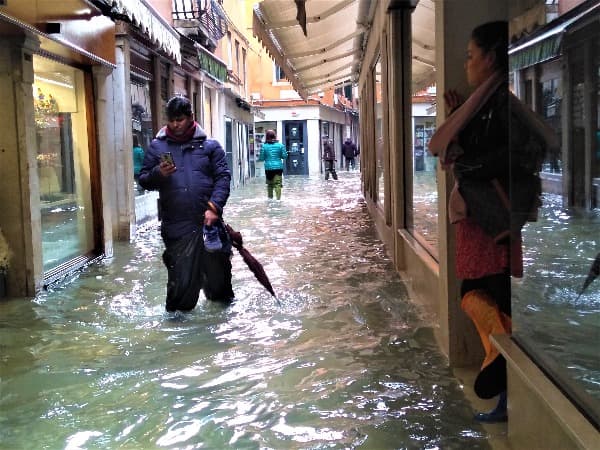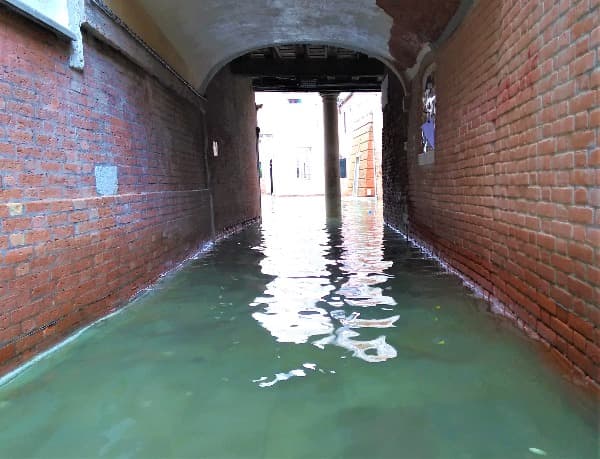Venice under water
Today at 10 am. the water in Venice was 144 cm. So, we who live here, all know what that means. We talk about 95cm… 120cm… 110, that’s when the doorway is flooded. 95, that’s when You have to take another way down to the Vaporetto. Every centimeter has its own code, what shoes to wear, what route to follow, what door to use.
 The origin is a series of water levels measured at Punta della Dogana, across the Canal Grande from Saint Mark’s Square, in 1897. That year the statistically medium sea level was fixed at 0. From there we then calculate the tides every day throughout the year. Sea level is around 30-35 cm higher today than in 1897. On top of that, the high waters are more frequent and higher than in the 19th century.
The origin is a series of water levels measured at Punta della Dogana, across the Canal Grande from Saint Mark’s Square, in 1897. That year the statistically medium sea level was fixed at 0. From there we then calculate the tides every day throughout the year. Sea level is around 30-35 cm higher today than in 1897. On top of that, the high waters are more frequent and higher than in the 19th century.
At 100 cm, the problem starts
Anyway, around 100cm, that’s where the problems start. At that level, 10 % of Venice is under water. Not more than that you can get through with gore-tex shoes. Saint Mark’s Square starts flooding at 85 centimeters. At 1 meter the whole square is covered in water. So 144 centimeters is very high… It’s actually the 14th highest tide ever and on Saint Mark’s you have half a meter of water.
But the real problem wasn’t that. 144 centimeters… Well, we can manage. We have pumps and drainage, we have panels at the doors, and sealant and tape. It’s not the first time it happens, it’s a pain, everything gets wet, the shops and restaurants lose a lot of cash, children stay home from school, offices close… But in the end, we cope. As we’ve always done. The high tide is a part of living in Venice. We just wait it out, and then life continues.
… But this time it was different. It was supposed to be 145, then 150… Then suddenly it just wouldn’t stop raising and together with the strong wind, it stopped at 187 cm. And that’s when many security systems start to break. In fact, in Saint Mark’s Basilica, the water was only centimeters from reaching levels that could jeopardize the priceless treatures inside the dome.
We just weren’t prepared. And how could we have been?
First, the expectations were 145cm, then they said 160cm. It wasn’t really until right before the peak that we understood the gravity of the situation. Because the ICPSM keeps track of the tides and water levels at all times, but there is always a variety of factors that they can’t know in advance. It’s like the weather forecasts.
At 10.20 pm, 90% of the city of Venice was under water. Only once since the measuring started a higher level has been registered… 1966 when the famous Acqua Granda hit Venice. 3 deaths, a complete blackout for several days, hundreds of Gondole were destroyed. As were 75% of the shops, offices, and laboratories, as well as thousands of tons of goods. There are books, films, theater plays, and even an opera about that event. It’s something that every Venetian remembers or knows from their parents or grandparents.
There are new records every year
And now we were 7 centimeters from that record… 7 centimeters! It’s been estimated a loss from damage on goods, furnishing, and buildings on several hundred millions of euro. In the Basilica, they have a sophisticated system of drains and pumps to prevent what happened in 1966 to happen again. But it’s still a question of panels and pumps. There just is no other way to keep water out. And it is a difficult, not to say futile struggle. After a few hours, the water levels sink and after a few days, it may seem as if it’s all resolved. But inside the walls, the salt remains. Because the higher the level, the more of the water is seawater and the salt in it is highly corrosive. It’s not only the wetness and the humidity that threatens the city… The salt is an equally dangerous enemy.
Six times the Basilica has been flooded, since the beginning of times. Six times in 1200 years. Not much but considering that three of those happened in the last 20 years, and two of them in a little more than one year. The last one in October 2018.
But Venice is more under water for each year
 Of the highest 20 floodings of all times, 5 were in the two years 2018 and 2019. And 2019 isn’t over yet. Friday the 15th of November they have predicted another day with 145 centimeters, and on Sunday the 17th, there could be another extreme high water. We pray it doesn’t happen.
Of the highest 20 floodings of all times, 5 were in the two years 2018 and 2019. And 2019 isn’t over yet. Friday the 15th of November they have predicted another day with 145 centimeters, and on Sunday the 17th, there could be another extreme high water. We pray it doesn’t happen.
Edit: In fact, on November 15 we had 154cm and on November 17 150cm. That’s 6 of the 20 highest tides of all times in the last two years.
I have changed my view of things a little bit since Tuesday. And I know many of my fellow citizens have too. We still carry on, we put up our panels, and we dry our houses afterwords, but there is a slight, barely recognizable change in the air. And it has to do with the future.
The statistics are quite clear; we are heading towards a wetter future with higher tides and more water on the streets. But it’s different reading news articles, and seeing it on TV, compared to living it, compared to have in your living room. This time it was 187cm… What will it be next time? 195? 210? 267?. And when? Next year? In ten years?
It’s not a matter of if but of when. And am I really prepared to stay put and watch how this wonderful city becomes completely submerged by water? Do I want to fight till the end if there’s really nothing to fight for? The MOSE-project is supposed to guarantee the lagoon against sea levels up until 67 centimeters higher than today. It should guarantee the safety to the lagoon and the surroundings, because the whole territory is extremely low, up until high waters of 3 meters. And the MOSE isn’t operational yet… After more than 15 years!
There is no doubt those days will come, the days when not even MOSE can save us. The question is, are we going to sit here and wait for it, while our feet get wet and the walls of our houses crumble? Am I going to grow my children in a place that we know has no future? Or should I sell now, while I still can get good money for the house? Because fortunately, the buyers of real estate in Venice do not read the papers, they don’t follow the public debate, and they don’t read the reports from IPCC
